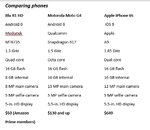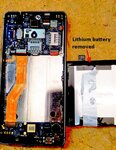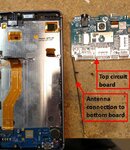By Lee Teschler, EEWorld Executive Editor
The online retailer Amazon made headlines when it introduced a super-inexpensive smart phone from Blu Products in Miami called the R1 HD. The media splash arose because Amazon Prime members could get the phone for as little as $50 if they were willing to put up with seeing ads on the phone’s lock screen.


With high-end phones like the iPhone going for somewhere north of $600, you might wonder what you get in a phone selling for less than one-sixth that amount. It is interesting to make a few basic comparisons with the iPhone 6S. Some of the more notable differences are the processors, memory, and cameras. The Blu phone uses a 1.3 GHz quad-core processor from Mediatek in Taiwan. Meanwhile the iPhone uses a 1.85 GHz dual-core processor of Apple’s design. The iPhone has twice as much RAM, 2 Gb compared to 1 Gb in the Blu, and 16 Gb of storage compared to 8 Gb in the Blu. But owners can upgrade the Blu to the same amount of memory and storage as the iPhone for only about ten dollars or so.
Both phones have a five-megapixel camera for selfies but the iPhone has a 12-megapixel camera in front compared to an eight-megapixel front camera for the Blu. So the quality of the images isn’t as good on the Blu.
We didn’t try using the phone because we would have had to add a sim card and sign up with a wireless carrier to make use of its features. But reports in the press we’ve seen say the front camera isn’t as good as that on higher end phones. That makes sense in that the Blu camera has only two-thirds as much resolution as those on higher end phones.

The front camera, left, occupies about twice the volume of the selfie camera, right.
A rule of thumb about cameras is that the deeper the camera body, the better the picture it takes simply because cameras with more depth to them have more room for optical components. With the Blu’s front and back cameras next to each other, it’s easy to see that the selfie camera is shallower than the main camera, meaning it just doesn’t have the same quality of internals.
Removing the back cover
The exterior back of the phone comes off readily, a plus if the phone’s lithium battery ever needs replacement. And the battery has only one connection to the PCB so it detaches easily. The back of the phone case comes off with the removal of a few super tiny torx screws. But there are no facilities for wireless charging in the Blu phone. A lack of wireless charging seems to be part of the price you pay for a cheap smart phone, at least for now.
But once you’re in the phone, you can begin to see why the cost of smart phones has come down. It used to be that smart phones contained two separate CPUs. One would handle the network protocol and the basic functions of a phone. The other would run the user interface and applications. The architecture was as though a PDA, or a personal digital assistant, had been combined with an old-fashioned feature phone. The two processors had a thin communication interface and operated independently of each other.
But the R1 HD we examined has only one processor chip which obviously handles both PDA and phone functions. That chip is what’s called a... Read the entire Teardown of the Blu R1 HD on EEWorldonline.
Want to read more of Lee's Teardowns? Check them out here
The online retailer Amazon made headlines when it introduced a super-inexpensive smart phone from Blu Products in Miami called the R1 HD. The media splash arose because Amazon Prime members could get the phone for as little as $50 if they were willing to put up with seeing ads on the phone’s lock screen.
With high-end phones like the iPhone going for somewhere north of $600, you might wonder what you get in a phone selling for less than one-sixth that amount. It is interesting to make a few basic comparisons with the iPhone 6S. Some of the more notable differences are the processors, memory, and cameras. The Blu phone uses a 1.3 GHz quad-core processor from Mediatek in Taiwan. Meanwhile the iPhone uses a 1.85 GHz dual-core processor of Apple’s design. The iPhone has twice as much RAM, 2 Gb compared to 1 Gb in the Blu, and 16 Gb of storage compared to 8 Gb in the Blu. But owners can upgrade the Blu to the same amount of memory and storage as the iPhone for only about ten dollars or so.
Both phones have a five-megapixel camera for selfies but the iPhone has a 12-megapixel camera in front compared to an eight-megapixel front camera for the Blu. So the quality of the images isn’t as good on the Blu.
We didn’t try using the phone because we would have had to add a sim card and sign up with a wireless carrier to make use of its features. But reports in the press we’ve seen say the front camera isn’t as good as that on higher end phones. That makes sense in that the Blu camera has only two-thirds as much resolution as those on higher end phones.
The front camera, left, occupies about twice the volume of the selfie camera, right.
A rule of thumb about cameras is that the deeper the camera body, the better the picture it takes simply because cameras with more depth to them have more room for optical components. With the Blu’s front and back cameras next to each other, it’s easy to see that the selfie camera is shallower than the main camera, meaning it just doesn’t have the same quality of internals.
Removing the back cover
The exterior back of the phone comes off readily, a plus if the phone’s lithium battery ever needs replacement. And the battery has only one connection to the PCB so it detaches easily. The back of the phone case comes off with the removal of a few super tiny torx screws. But there are no facilities for wireless charging in the Blu phone. A lack of wireless charging seems to be part of the price you pay for a cheap smart phone, at least for now.
But once you’re in the phone, you can begin to see why the cost of smart phones has come down. It used to be that smart phones contained two separate CPUs. One would handle the network protocol and the basic functions of a phone. The other would run the user interface and applications. The architecture was as though a PDA, or a personal digital assistant, had been combined with an old-fashioned feature phone. The two processors had a thin communication interface and operated independently of each other.
But the R1 HD we examined has only one processor chip which obviously handles both PDA and phone functions. That chip is what’s called a... Read the entire Teardown of the Blu R1 HD on EEWorldonline.
Want to read more of Lee's Teardowns? Check them out here








